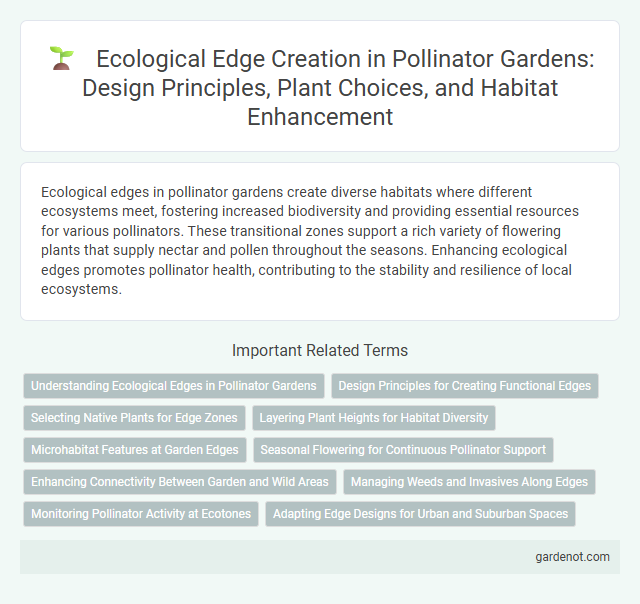Ecological edges in pollinator gardens create diverse habitats where different ecosystems meet, fostering increased biodiversity and providing essential resources for various pollinators. These transitional zones support a rich variety of flowering plants that supply nectar and pollen throughout the seasons. Enhancing ecological edges promotes pollinator health, contributing to the stability and resilience of local ecosystems.
Understanding Ecological Edges in Pollinator Gardens
Ecological edges in pollinator gardens create diverse habitats where different ecosystems intersect, increasing plant variety and pollinator activity. These transition zones support a rich array of insects, birds, and other wildlife by offering varied resources such as nectar, shelter, and nesting sites. Understanding and enhancing ecological edges fosters biodiversity and strengthens pollination networks essential for garden health and productivity.
Design Principles for Creating Functional Edges
Ecological edges in pollinator gardens enhance biodiversity by creating varied microhabitats that support different pollinator species. Design principles include layering native plants by height and bloom time to provide continuous resources and shelter, optimizing habitat connectivity and minimizing disturbance zones. Functional edges increase ecological resilience, promoting pollinator health and ecosystem services through strategic spatial arrangement and plant selection.
Selecting Native Plants for Edge Zones
Selecting native plants for ecological edge zones enhances biodiversity by providing essential habitat and food sources tailored to local pollinators. These plants support native bees, butterflies, and birds by offering diverse bloom times and shelter throughout the growing season. Incorporating species such as goldenrod, purple coneflower, and milkweed creates a resilient pollinator garden that thrives at the interface between different ecosystems.
Layering Plant Heights for Habitat Diversity
Layering plant heights in a pollinator garden creates an ecological edge that enhances habitat diversity by providing varied microenvironments for different pollinator species. Taller plants offer shelter and perching sites, while mid-height and ground-level vegetation supply nectar, pollen, and nesting materials. This stratification supports a wide range of pollinators, from butterflies to bees, promoting ecosystem resilience and biodiversity.
Microhabitat Features at Garden Edges
Garden edges create vital ecological edges that support diverse microhabitats, enhancing pollinator activity and biodiversity. Features like varied vegetation layers, native flowering plants, and sheltered nooks provide essential resources such as nectar, pollen, and nesting sites. These microhabitats promote healthy pollinator populations by offering refuge and connectivity within fragmented landscapes.
Seasonal Flowering for Continuous Pollinator Support
Creating an ecological edge with diverse, seasonal flowering plants ensures continuous pollinator support by providing nectar and pollen resources throughout the year. Incorporating native wildflowers, shrubs, and early blooming species enhances habitat connectivity and sustains populations of bees, butterflies, and other pollinators during critical times. This strategic planting approach promotes biodiversity, improves pollination services for nearby crops, and strengthens ecosystem resilience.
Enhancing Connectivity Between Garden and Wild Areas
Creating an ecological edge by incorporating native plants and structural diversity enhances connectivity between pollinator gardens and surrounding wild areas. This transition zone supports diverse pollinator species by providing continuous foraging resources and safe habitat corridors. Strengthening these connections increases biodiversity and promotes ecosystem resilience within fragmented landscapes.
Managing Weeds and Invasives Along Edges
Managing weeds and invasives along the ecological edges of a pollinator garden is critical for maintaining biodiversity and supporting native pollinator species. Implementing targeted manual removal and selective herbicide application minimizes competition, allowing native plants to thrive and provide essential resources like nectar and pollen. Consistent monitoring and edge-focused management enhance garden resilience, promoting a balanced ecosystem that supports diverse pollinator populations.
Monitoring Pollinator Activity at Ecotones
Monitoring pollinator activity at ecological edges, or ecotones, reveals higher biodiversity due to the convergence of distinct habitats supporting diverse pollinator species. These transitional zones provide abundant floral resources and microhabitats, promoting pollination efficiency and ecosystem resilience. Systematic observation and data collection at ecotones enhance understanding of pollinator dynamics crucial for conservation strategies in pollinator gardens.
Adapting Edge Designs for Urban and Suburban Spaces
Adapting edge designs for urban and suburban pollinator gardens enhances biodiversity by creating diverse habitats that support various pollinator species. Incorporating native plants with staggered bloom times along garden perimeters increases floral resources and nesting opportunities, promoting ecological resilience. Utilizing layered vegetation and minimizing hard edges fosters connectivity between green spaces, facilitating pollinator movement and habitat continuity.
Ecological edge Infographic

 gardenot.com
gardenot.com